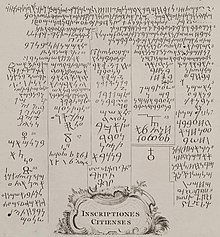|
Kanaanäische und Aramäische InschriftenKanaanäische und Aramäische Inschriften (in English, Canaanite and Aramaic Inscriptions), or KAI, is the standard source for the original text of Canaanite and Aramaic inscriptions not contained in the Hebrew Bible. It was first published from 1960 to 1964 in three volumes by the German orientalists Herbert Donner and Wolfgang Röllig, and has been updated in numerous subsequent editions.[1] The work attempted to "integrate philology, palaeography and cultural history" in the commented re-editing of a selection of Canaanite and Aramaic Inscriptions, using the "pertinent source material for the Phoenician, Punic, Moabite, pre-exile-Hebrew and Ancient Aramaic cultures."[2] Röllig and Donner had the support of William F. Albright in Baltimore, James Germain Février in Paris and Giorgio Levi Della Vida in Rome during the compilation of the first edition.[3] EditionsThe 4th edition was published between 1966 and 1969, and a 5th edition was published in 2002. However, the 5th edition only comprised the first volume (showing the texts in modern Hebrew script), expanding the previous edition by 40 texts. An updated version of the third volume (a brief bibliography of all the texts in Volume 1) was proposed.[4] The first edition was intended to represent all the known texts of significant importance, but not to be a complete collection to replace the Corpus Inscriptionum Semiticarum. With respect to Aramaic inscriptions, all stone inscriptions until the Achaemenid Empire were included, whereas Imperial Aramaic inscriptions are only partially represented. Less emphasis was put on Aramaic papyri, ostraca and clay tablets, as such collections either already existed or were being prepared elsewhere. The included papyri and ostraca were chosen in order to provide and objective rounding of the picture, such as if they were published in a remote location. Nabataean and Palmyrene inscriptions were excluded, as were most of the Elephantine papyri.[5] The inscriptions were ordered geographically, and then chronologically within each geography; a division was made between “Punic” and “Neo Punic” that was acknowledged to be subjective.[6] In the second edition, four new texts were added - the fourth of the Karatepe inscriptions (KAI 26), and the three new texts (KAI 277-279). In the fifth edition, 40 new texts were added, primarily because they were only discovered or published after the appearance of the original edition or - like the Agrigentum inscription (KAI 302) - were given a new relevance due to a recent interpretation.[7] Two groups of new texts were not included in the fifth edition: new Hebrew inscriptions, which were considered to have been well summarized in J. Renz / W. Röllig, Handbuch der Althebraische Epigraphik (Darmstadt 1995-2002) and the Imperial Aramaic texts from Egypt, which were considered to have been well summarized in the Textbook of Aramaic Documents from Ancient Egypt.[8] Phoenician inscriptionsA.I: From "the Motherland" (KAI 1-22, 280-286)
Roueisseh
A.II: From Syria and Asia Minor (KAI 23-29, 287)
A.III: From the islands (KAI 30-47, 288-292)
A.IV: From Egypt (KAI 48-52)
A.V: From Greece (KAI 53-60, 293)
A.Addition: From mainland Europe (KAI 277, 294)
Punic inscriptionsB.I: From the islands (KAI 61-68, 295-301)
B.II. From mainland Europe (KAI 69-72)
B.III. From Africa (KAI 73-116, 302-305)
Neopunic inscriptionsC.I: From Africa (KAI 117-171)
C.II: From Sardinia (KAI 172-173)
D. Moabite and Ammonite inscriptions (KAI 181, 306, 307-308)
E. Hebrew inscriptions (KAI 182-200)
F. Aramaic inscriptionsF.I: From Syria, Palestine and the Arabian Desert (KAI 201-230, 309-317)Bureij
Samos
F.II: From Assyria (KAI 231-257)
F.III: From Asia Minor (KAI 258-265, 278, 318-319)
F.IV: From Egypt (KAI 266-272)
F.V: From the outlying areas (KAI 273-276, 279, 320)
AppendicesAppendix I. Phoenician and Punic inscriptions in Greek script (KAI 174-177)Appendix II. Latin-Libyan inscriptions (KAI 178-180)
References
Bibliography
See also |